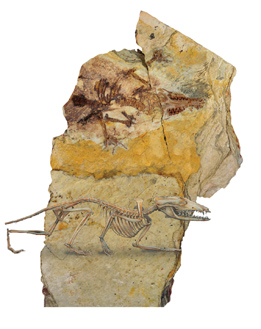 Winter 2011
Winter 2011
Our “Jurassic mother”
This past August, Zhe-Xi Luo, Carnegie Museum of Natural History’s renowned mammal expert, once again had the science world abuzz over his latest discovery: the earliest ancestor of most of today’s mammals.
The tiny shrew-like creature named Juramaia sinensis or “Jurassic mother from China” is the earliest known placental mammal—animals, such as humans, that have a placenta to nourish its unborn offspring. “Because it lived 160 million years ago and nobody was there to sign the birth certificate of its descendants, Juramaia could be either our great-grandmother or great-grand-aunt that represents a relative on the sidelines,” explains Luo. Discovered in the Liaoning Province of northeast China, the remarkably well-preserved fossil includes portions of the animal’s skull, jawbone, and skeleton as well as impressions of residual soft tissues such as hair. Most importantly, it shows a near-complete set of teeth of the ancient mammal and bones of its forepaw. It’s those features that led Luo and his collaborators, a team of paleontologists from China, to conclude that the animal was closer to living placentals on the mammalian family tree than to pouched marsupials, such as kangaroos. Both lineages—placentals and marsupials—started out small and got lucky breaks when they moved up into the forest canopy, out of reach of most dinosaurs and other mammals that stalked the ground, notes Luo. The fossils represent a new milestone in mammal evolution that scientists now know was reached 35 million years earlier than previously thought, filling an important gap in the fossil record and helping to calibrate how fast DNA evolved in mammals. What forced the evolutionary split, however, remains a mystery.
Here comes the SunThanks to a $762,208 award from none other than NASA, Carnegie Science Center is set to develop a sunny new educational experience geared to students in grades 4-8 on the topic of heliophysics—the exploration of the Sun and its effects on Earth and all the planets of the solar system. Called SolarQuest: Exploration of the Sun-Earth System, it will tap into NASA’s unmatched pool of imagery, data, and science experts to educate kids about the environment in which the Earth travels and the ways in which the Sun and its interactions with the planet affect human life. The SolarQuest school experience will boast a number of components, including a 10-minute “fly-through” of the Sun-Earth environment produced by Science Center staff for the full-dome Buhl Digital Planetarium. The program will be distributed to other planetariums around the country, and the world. Also in the works is a 45-minute assembly show for up to 250 students—the latest in the Science Center’s large arsenal of Science on the Road programs—that will incorporate live performances and props, stunning imagery provided by NASA, recorded interviews with NASA scientists, live physics and chemistry demonstrations, and audience participation through 10 hands-on learning stations that will reinforce the scientific concepts presented in the assembly show. Finally, the SolarQuest experience will extend online to teachers, who will be able to access class materials through the Science Center’s website. “Like NASA, the Science Center has long used the wonder and beauty of the cosmos as a gateway to excite students about science, and to motivate them toward careers in astronomy and space science,” says John Radzilowicz, director of science & education for Carnegie Science Center. “SolarQuest will build on those synergies to present the frontiers of heliophysics to students, teachers, and the general public—regionally, nationally, and internationally.”
At the head of the tableA pair of seasoned leaders has joined the distinguished ranks of board chairs at Carnegie Museums of Pittsburgh. This past fall, Jane Kirkland assumed the leadership post at Carnegie Science Center after serving on its board since 1996, and Marty McGuinn took the reigns at Carnegie Museum of Art following 20 years of board service. Both are life trustees of Carnegie Museums. Kirkland runs her own consulting practice, Kirkland Partners, LLC, a firm that works with large corporations and private equity companies in the areas of business strategy, knowledge management, and corporate learning. Prior to establishing her own business, Kirkland was vice president and chief information officer at Pittsburgh-based FreeMarkets. She succeeds Ray Betler, another longtime Science Center supporter, as board chair. “Carnegie Science Center has been very fortunate in having an active, thoughtful, and committed board,” says Ann Metzger, the Henry Buhl, Jr., Co-director of the Science Center. “Jane has a thorough understanding of the organization and extraordinary dedication to our mission. She is an ideal board chair.” McGuinn, who retired in 2006 as chairman and chief executive officer of Mellon Financial Corporation, now The Bank of New York Mellon, succeeds Bill Hunt, who served as chair since 2006. “Marty’s track record as an active member of our board and a trustee of Carnegie Museums of Pittsburgh, plus his community involvement throughout the region, inside and outside Pittsburgh, will make his insights and leadership invaluable to our organization,” says Lynn Zelevansky, The Henry J. Heinz II Director of Carnegie Museum of Art.
Reel newsA $325,000 grant from The Andrew W. Mellon Foundation is allowing Carnegie Museum of Art to take the important first step of studying a lesser-known but no less important part of its collection: its 920 moving-image artworks. With an eye toward artistic and historical significance, a team comprised of staff from the Museum of Art and its sister museum, The Andy Warhol Museum, will survey the museum’s holdings of time-based media and then devise a detailed plan for the management, preservation, and accessibility of the collection for both public and scholarly use. “Carnegie Museum of Art was one of the first major U.S. museums to embrace media arts,” says Lynn Zelevansky, The Henry J. Heinz II Director of Carnegie Museum of Art. “Since 1969, the growth of our collection has reflected the growth in importance of film, video, and digital media in the art world. We seek to take on a stronger role as a repository and presenter of media arts for the local and global audiences we serve. With the efforts funded by this grant, we are laying the groundwork for meeting that goal.”
It pays to play…On Facebook, that is! Carnegie Museums is calling all members who want to keep up-to-date on all the latest museum news, inside scoops, and, yes, members-only it-pays-to-play contests: “Like” the new Carnegie Museums Members Page today. This members-only community debuted this past summer in concert with the Members-Only Summer Museum Adventure contest, a mobile scavenger hunt that gave even the most frequent museum-goers new things to discover about the museums they love. Participating members checked in on their phones at the Oakland museums, the Science Center, and The Warhol, at which time they set out on a mobile question-and-answer session that led them on a fact-finding mission through the museums. The payoff for the participants who got the most correct answers? Fun, interesting new knowledge, and really cool prizes. Winning members and their loot were: Grand-prize winner Ryan McDermott, who earned $500 in Carnegie Cash; Amy Cross, who hit the Jurassic jackpot, winning a VIP tour of Dinosaurs in Their Time for her and nine guests; and Kelly McDonnell, who muscled her way into a VIP tour of Heroes & Villains: The Comic Book Art of Alex Ross for her and nine guests. Let’s build this community together. You bring your curiosity. We’ll bring an insider’s perspective—and occasionally, some really awesome prizes.
|
The ABCs of Discovery · Photographing My People · International Negotiations · The Art of Reading a Face · Director's Note · Face Time: Linda Ortenzo · About Town: Game On · Artistic License: Contemporary Craft · The Big Picture
 |
Copyright © 2017 CARNEGIE Magazine. All rights reserved. |





